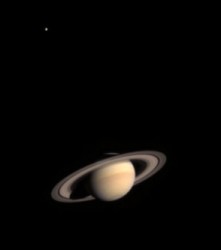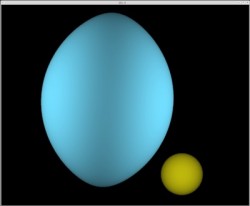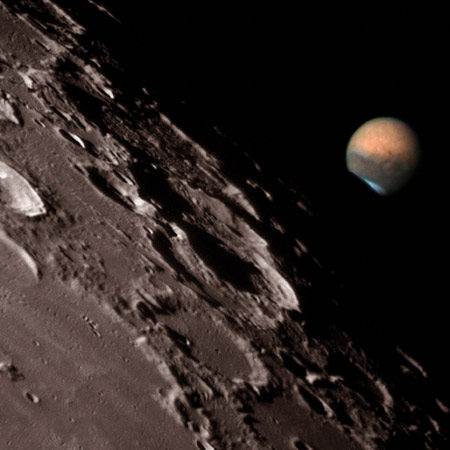Greetings, fellow SkyWatchers! As the summer heats up for the northern hemisphere and the winter cools down the southern, we’re in for interesting celestial scenery over the next few days. No special equipment is needed – only your eyes and the knowledge of knowing where and when to look….
On the universal date of Sunday, June 8, 2008 the Red Planet – Mars – and the Moon will make a splendid showing for all. As skies darken, look for impressive pair along the western ecliptic. For most of us, Mars and the earthshine Moon will only be separated by about a degree, but for lucky observers in New Zealand, this will be an occultation event! (For specific details on times and areas, please check IOTA information.) Get out your binoculars and have a look. Even the youngest SkyWatcher will easily be able to find Mars!
While the Phoenix mission is still making big news, use this opportunity to do some public astronomy outreach. Point the pair out in the sky to someone and tell what you know. Around 40 years has elapsed since humankind has first visited one – and then the other. How did our original expeditions to the Moon lead scientists to develop ever better instruments for remote study? How has our exploratory spacecraft evolved?
 If you think that’s cool… Then stay tuned for Monday, June 9, 2008 when the Moon, Saturn and Regulus team up in the night sky. To the unaided eye, the trio will make a lovely triangle with the Ringed Planet and the Little King situated to the north of Selene. Again, it’s a great time to do some public outreach! Point a telescope Saturn’s way. Titan – Saturn’s largest moon – is visibly bright and can be seen in even small telescopes. Explain how our original fly-bys and landings on our own Moon led us on to explore a moon on a distant world! What did we find on Titan? How can it compare to what we discovered on the Moon and Mars?
If you think that’s cool… Then stay tuned for Monday, June 9, 2008 when the Moon, Saturn and Regulus team up in the night sky. To the unaided eye, the trio will make a lovely triangle with the Ringed Planet and the Little King situated to the north of Selene. Again, it’s a great time to do some public outreach! Point a telescope Saturn’s way. Titan – Saturn’s largest moon – is visibly bright and can be seen in even small telescopes. Explain how our original fly-bys and landings on our own Moon led us on to explore a moon on a distant world! What did we find on Titan? How can it compare to what we discovered on the Moon and Mars?
 Don’t forget Regulus, either. The light you see from it on this night would have left roughly in 1931 – long before expeditions to the Moon, Saturn and Mars were even dreamed of. At about three and a half times more massive than our own Sol, Regulus is one hot customer when it comes to spin rate. Revolving completely on its axis in a little less than 16 hours, oblate Regulus would fly apart if it were moving any faster! Even though it’s been around for a few million years, Regulus isn’t alone, either. The “Little King” is a multiple star system composed of a hot, bright, bluish-white star with a pair of small, faint companions.
Don’t forget Regulus, either. The light you see from it on this night would have left roughly in 1931 – long before expeditions to the Moon, Saturn and Mars were even dreamed of. At about three and a half times more massive than our own Sol, Regulus is one hot customer when it comes to spin rate. Revolving completely on its axis in a little less than 16 hours, oblate Regulus would fly apart if it were moving any faster! Even though it’s been around for a few million years, Regulus isn’t alone, either. The “Little King” is a multiple star system composed of a hot, bright, bluish-white star with a pair of small, faint companions.
Even if you only use your eyes, the next few days are a great opportunity to share what you love and know with others… Enjoy!
Moon Occulting Mars Image – Credit: Ron Dantowitz, Clay Center Observatory at Dexter and Southfield Schools. Saturn and Titan – Credit: Casinni/NASA. Regulus vs. the Sun – Wenjin Huang


Good job, Tammy! Now could you just chase these thunderstorms away?
good stuff as always. thnx
Yes, I agree, I enjoy these writings, power to your pen or key board Tammy! Keep up the good work
Best wishes from The York Astronomical Society, England
Thanks for the heads up, Tammy! I know how I will be spending my evening…
~Nick
Thanks for the info. I have a scope, but I live near the coast and sometimes it gets fogging over night.
LOL… Yep. Spammed here, too.
Thank all of you for the nice comments. I hope you got to see it! I had a whole herd of kids with binoculars on the Moon and Mars during a public outreach program. Nothing fires up their imaginations better..
As for Saturn? Duck!!! The tornadoes just blew by here in Ohio…
Off to OZ,
~Tam
well try to photograph the event from Benghazi
in N.Africa, thanks for the information,I am trying hard to get people around here interested in space you can not imagine how hard it is…hafid
You’re awesome Tammy!